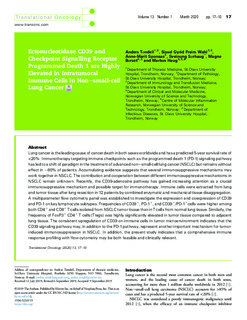| dc.contributor.author | Tøndell, Anders | |
| dc.contributor.author | Wahl, Sissel Gyrid Freim | |
| dc.contributor.author | Sponaas, Anne-Marit | |
| dc.contributor.author | Sørhaug, Sveinung | |
| dc.contributor.author | Børset, Magne | |
| dc.contributor.author | Haug, Markus | |
| dc.date.accessioned | 2019-11-18T12:03:01Z | |
| dc.date.available | 2019-11-18T12:03:01Z | |
| dc.date.created | 2019-11-14T08:50:34Z | |
| dc.date.issued | 2019 | |
| dc.identifier.citation | Translational Oncology. 2019, 13 (1), 17-24. | nb_NO |
| dc.identifier.issn | 1944-7124 | |
| dc.identifier.uri | http://hdl.handle.net/11250/2629020 | |
| dc.description.abstract | Lung cancer is the leading cause of cancer death in both sexes worldwide and has a predicted 5-year survival rate of <20%. Immunotherapy targeting immune checkpoints such as the programmed death 1 (PD-1) signaling pathway has led to a shift of paradigm in the treatment of advanced non–small-cell lung cancer (NSCLC) but remains without effect in ∼80% of patients. Accumulating evidence suggests that several immunosuppressive mechanisms may work together in NSCLC. The contribution and cooperation between different immunosuppressive mechanisms in NSCLC remain unknown. Recently, the CD39-adenosine pathway has gained increasing attention as a crucial immunosuppressive mechanism and possible target for immunotherapy. Immune cells were extracted from lung and tumor tissue after lung resection in 12 patients by combined enzymatic and mechanical tissue disaggregation. A multiparameter flow cytometry panel was established to investigate the expression and coexpression of CD39 and PD-1 on key lymphocyte subtypes. Frequencies of CD39+, PD-1+, and CD39+/PD-1+cells were higher among both CD4+ and CD8+ T cells isolated from NSCLC tumor tissue than in T cells from normal lung tissue. Similarly, the frequency of FoxP3+ CD4+ T cells (Tregs) was highly significantly elevated in tumor tissue compared to adjacent lung tissue. The consistent upregulation of CD39 on immune cells in tumor microenvironment indicates that the CD39 signaling pathway may, in addition to the PD-1 pathway, represent another important mechanism for tumor-induced immunosuppression in NSCLC. In addition, the present study indicates that a comprehensive immune response profiling with flow cytometry may be both feasible and clinically relevant. | nb_NO |
| dc.language.iso | eng | nb_NO |
| dc.publisher | Elsevier | nb_NO |
| dc.rights | Attribution-NonCommercial-NoDerivatives 4.0 Internasjonal | * |
| dc.rights.uri | http://creativecommons.org/licenses/by-nc-nd/4.0/deed.no | * |
| dc.title | Ectonucleotidase CD39 and Checkpoint Signalling Receptor Programmed Death 1 are Highly Elevated in Intratumoral Immune Cells in Non–small-cell Lung Cancer | nb_NO |
| dc.type | Journal article | nb_NO |
| dc.type | Peer reviewed | nb_NO |
| dc.description.version | publishedVersion | nb_NO |
| dc.source.pagenumber | 17-24 | nb_NO |
| dc.source.volume | 13 | nb_NO |
| dc.source.journal | Translational Oncology | nb_NO |
| dc.source.issue | 1 | nb_NO |
| dc.identifier.doi | https://doi.org/10.1016/j.tranon.2019.09.003 | |
| dc.identifier.cristin | 1747355 | |
| dc.description.localcode | © 2019 The Authors. Published by Elsevier Inc. on behalf of Neoplasia Press, Inc. This is an open access article under the CC BY-NC-ND license (http://creativecommons.org/licenses/ by-nc-nd/4.0/). | nb_NO |
| cristin.unitcode | 194,65,25,0 | |
| cristin.unitcode | 194,65,15,0 | |
| cristin.unitname | Institutt for sirkulasjon og bildediagnostikk | |
| cristin.unitname | Institutt for klinisk og molekylær medisin | |
| cristin.ispublished | true | |
| cristin.fulltext | original | |
| cristin.qualitycode | 1 | |

